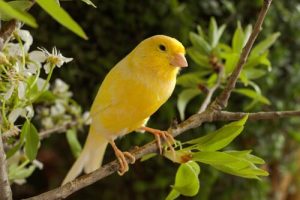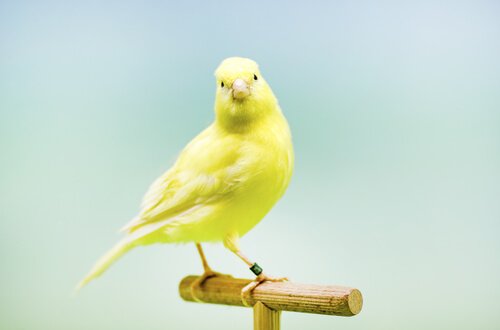Tips on How to Care for a Canary


Written and verified by the lawyer Francisco María García
This type of animal is an ideal companion to have at home. In fact, the canary is one of the most popular birds to keep as a pet. It is not difficult to take care of them, as long as they receive enough attention. Even so, it is important that you take note of these tips, because in this article, we will explain all you need to know about how to care for a canary.
Origins
This type of bird is native to the Canary Islands, Azores and Madeira. It has an average life expectancy of 10 years, although some reach twice that age.
It is a gregarious and domestic animal, with a plumage that oscillates between yellow and green. Originally, its habitats were always open or semi-open spaces. Currently, there is a species that continues to live this way.
Stages and Particularities of the Species
For a canary’s experience in your home to be happy one, it is best to know all there is to learn how to care for a canary and all about this animal’s particular characteristics.
In this sense, an essential point to learn is knowing that the animal goes through three stages during the year: the shedding stage, the resting stage and the breeding stage. And each one has certain peculiarities.
The shedding stage spans from June to October, and that is when they completely shed and replace their plumage. It is very likely that the male will stop singing during this stage, which is normal.
As a far as a canary’s diet during this stage is concerned, it should be reinforced with several vitamins. Among other things, of course, because they need more energy to cope with the growth of their feathers.
During the resting stage, you will clearly notice improved plumage and better singing. This stage lasts from September to February.
The breeding stage is the time when they should be provided with a quiet environment and a nest. It lasts from January to June. In the event that they mate, they usually lay between three and five eggs. Incubation lasts about 15 days, in which both sexes of canaries will participate.
Which Cage to Choose
Among the other things you must do to take good care of your canary, your choice of cage is important, as it will either facilitate or decrease its motions. The dimensions should be (at least) between 30 and 50cm long, and should be 35cm wide, assuming you have only one bird.
Choosing one with a double bottom and a rectangular shape is ideal for easy cleaning.
Accessories
The feeders and water containers must be easy to handle and protected from animal droppings. Canaries are birds that take habitual baths. This is why it is necessary to provide a small birdbath in the cage and change the water daily.

Where to Locate a Canary’s Cage
You should choose a location that, when at all possible, will be the cage’s permanent resting spot. It must be placed far away from sources of direct heat or air currents. If it is inside, place it in a bright space that is out of reach from other pets.
If the cage is outside, be sure that it is not exposed to the sun’s rays or to extreme temperatures. The ideal temperature for your home is between 20ºC and 30ºC.
A Balanced Diet
A canary’s basic diet is seed-based. It should be a mixture of birdseed, millet, oats, etc. There are specially prepared combinations on the market for these birds that contain the appropriate amount of each type.
In addition to seeds, it is advisable to add pieces of mixed fruits and vegetables to your canary’s food. You should do this at least two or three times a week, while avoiding avocado–which is toxic to canaries.
It is essential that you to facilitate your canary’s ability to file its nails and its beak. To do this, the best thing is to provide your bird with a piece cuttlebone, which, moreover, is a source of calcium.
One important point of your canary’s care is that you must keep in mind the hygiene. Since the bird spends the entire day in the same space, you must be assure yourself that it remains clean. Sanitize the cage daily and change your bird’s drinking and bathing water on a daily basis. Be sure to also remove and replace any bits of food that your bird does not eat.
When to Consult a Veterinarian About Caring for a Canary
It is important that you learn the specific characteristics of canaries, as well as learn about its annual stages. You should immediately consult a trusted veterinarian if any of the following occur:
- The bird is less mobile than usual.
- It stops singing or its feathers begin to fall out, outside of the shedding stage.
- Its gaze is sad.
- It stops eating.
- It has discharge and inflammation around its eyes.
- Its breathing is heavier than usual and breathes with its beak open.
Great Housemates
Canaries are an ideal animal to have at home. They are not expensive to take care of, and mostly everyone thoroughly enjoys listening to them sing. As long as you take care of it, learn about its particularities, and stay on top its health and hygiene, the experience can be highly gratifying.
This type of animal is an ideal companion to have at home. In fact, the canary is one of the most popular birds to keep as a pet. It is not difficult to take care of them, as long as they receive enough attention. Even so, it is important that you take note of these tips, because in this article, we will explain all you need to know about how to care for a canary.
Origins
This type of bird is native to the Canary Islands, Azores and Madeira. It has an average life expectancy of 10 years, although some reach twice that age.
It is a gregarious and domestic animal, with a plumage that oscillates between yellow and green. Originally, its habitats were always open or semi-open spaces. Currently, there is a species that continues to live this way.
Stages and Particularities of the Species
For a canary’s experience in your home to be happy one, it is best to know all there is to learn how to care for a canary and all about this animal’s particular characteristics.
In this sense, an essential point to learn is knowing that the animal goes through three stages during the year: the shedding stage, the resting stage and the breeding stage. And each one has certain peculiarities.
The shedding stage spans from June to October, and that is when they completely shed and replace their plumage. It is very likely that the male will stop singing during this stage, which is normal.
As a far as a canary’s diet during this stage is concerned, it should be reinforced with several vitamins. Among other things, of course, because they need more energy to cope with the growth of their feathers.
During the resting stage, you will clearly notice improved plumage and better singing. This stage lasts from September to February.
The breeding stage is the time when they should be provided with a quiet environment and a nest. It lasts from January to June. In the event that they mate, they usually lay between three and five eggs. Incubation lasts about 15 days, in which both sexes of canaries will participate.
Which Cage to Choose
Among the other things you must do to take good care of your canary, your choice of cage is important, as it will either facilitate or decrease its motions. The dimensions should be (at least) between 30 and 50cm long, and should be 35cm wide, assuming you have only one bird.
Choosing one with a double bottom and a rectangular shape is ideal for easy cleaning.
Accessories
The feeders and water containers must be easy to handle and protected from animal droppings. Canaries are birds that take habitual baths. This is why it is necessary to provide a small birdbath in the cage and change the water daily.

Where to Locate a Canary’s Cage
You should choose a location that, when at all possible, will be the cage’s permanent resting spot. It must be placed far away from sources of direct heat or air currents. If it is inside, place it in a bright space that is out of reach from other pets.
If the cage is outside, be sure that it is not exposed to the sun’s rays or to extreme temperatures. The ideal temperature for your home is between 20ºC and 30ºC.
A Balanced Diet
A canary’s basic diet is seed-based. It should be a mixture of birdseed, millet, oats, etc. There are specially prepared combinations on the market for these birds that contain the appropriate amount of each type.
In addition to seeds, it is advisable to add pieces of mixed fruits and vegetables to your canary’s food. You should do this at least two or three times a week, while avoiding avocado–which is toxic to canaries.
It is essential that you to facilitate your canary’s ability to file its nails and its beak. To do this, the best thing is to provide your bird with a piece cuttlebone, which, moreover, is a source of calcium.
One important point of your canary’s care is that you must keep in mind the hygiene. Since the bird spends the entire day in the same space, you must be assure yourself that it remains clean. Sanitize the cage daily and change your bird’s drinking and bathing water on a daily basis. Be sure to also remove and replace any bits of food that your bird does not eat.
When to Consult a Veterinarian About Caring for a Canary
It is important that you learn the specific characteristics of canaries, as well as learn about its annual stages. You should immediately consult a trusted veterinarian if any of the following occur:
- The bird is less mobile than usual.
- It stops singing or its feathers begin to fall out, outside of the shedding stage.
- Its gaze is sad.
- It stops eating.
- It has discharge and inflammation around its eyes.
- Its breathing is heavier than usual and breathes with its beak open.
Great Housemates
Canaries are an ideal animal to have at home. They are not expensive to take care of, and mostly everyone thoroughly enjoys listening to them sing. As long as you take care of it, learn about its particularities, and stay on top its health and hygiene, the experience can be highly gratifying.
This text is provided for informational purposes only and does not replace consultation with a professional. If in doubt, consult your specialist.








